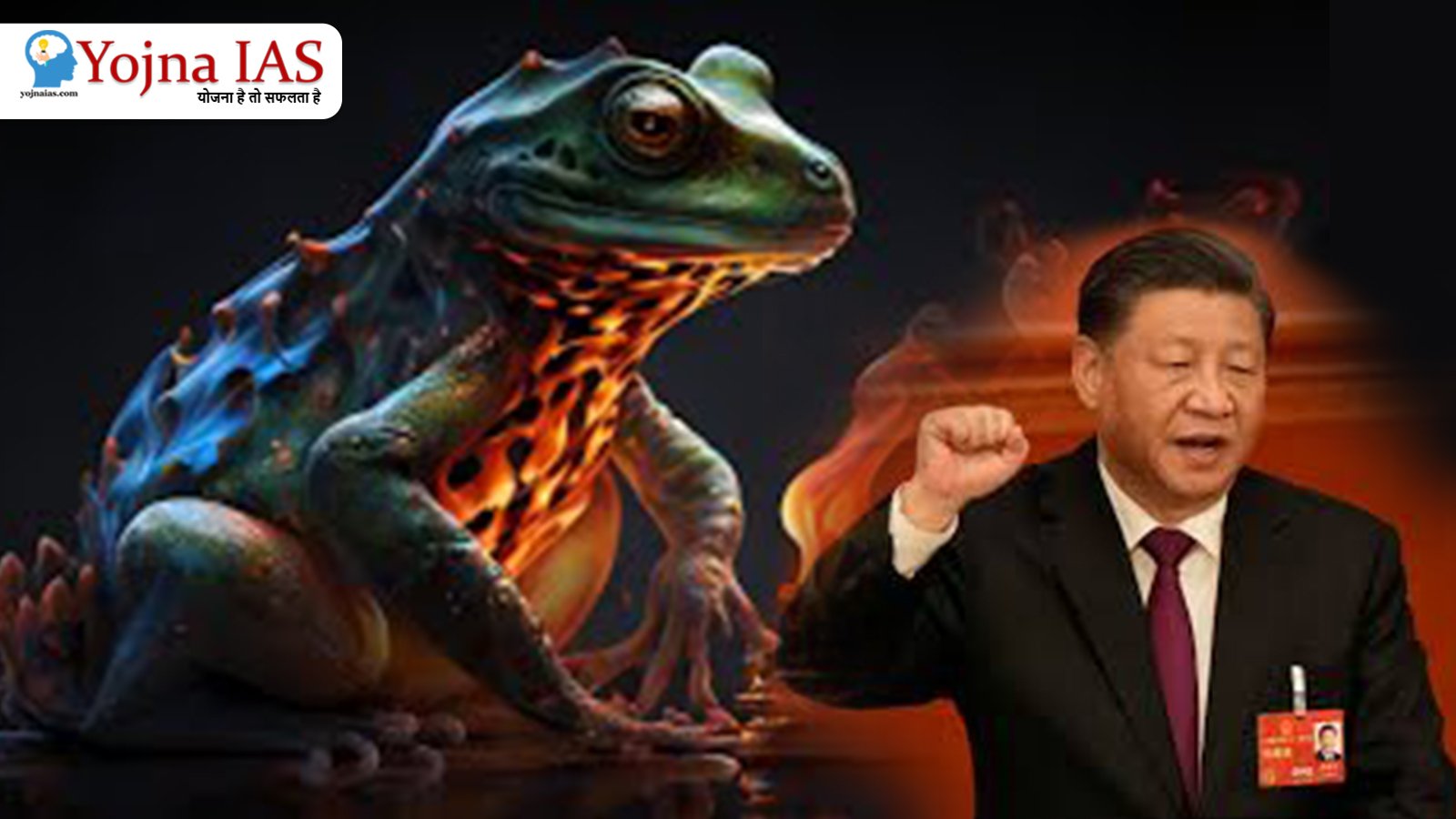01 May 2024 Boiling Frog Strategy of China
THIS ARTICLE COVERS ‘DAILY CURRENT AFFAIRS’ AND THE TOPIC DETAILS OF “Boiling Frog Strategy of China”. THIS TOPIC IS RELEVANT IN THE “International Relations” SECTION OF THE UPSC CSE EXAM.
Why in the news?
Recently, the commander of US forces in the Indo-Pacific region has accused China of pursuing a “boiling frog” strategy, raising tensions in the area with increasingly dangerous military activity. He said China stepped up its aggressive conduct through a “boiling frog” strategy, which gradually raised the temperature so that the ultimate danger was under-appreciated until it was too late. China had increased its pace of military development and matched its growing capabilities with more destabilising behaviour. He added that Beijing was engaged in a “might equal right” strategy throughout the region.

About the “boiling frog” strategy:
The “Boiling Frog Strategy” is often attributed to China’s approach to territorial expansion and geopolitical influence. The term originates from the anecdote about how a frog placed in tepid water that is slowly heated will not perceive the gradual increase in temperature and will eventually be boiled alive. It suggests a gradual and incremental approach to expanding its influence and power without triggering significant opposition or backlash from the international community.
China’s Boiling Frog strategy involves various tactics, including:
-
- Incremental territorial expansion: China has been accused of slowly expanding its territorial claims in the South China Sea by building artificial islands and asserting control over disputed territories. This incremental approach makes it challenging for other countries to mount a unified response.
- Economic coercion: China often uses its economic leverage to pressure other countries. This can involve offering loans and investments to gain influence or imposing economic sanctions to punish countries that oppose its interests.
- Soft power initiatives: China has been actively engaging in soft power initiatives such as the Belt and Road Initiative (BRI), which aims to enhance infrastructure connectivity and economic cooperation across Asia, Africa, and Europe. These initiatives help China expand its influence while projecting an image of cooperation and partnership.
- Information control: China tightly controls information within its borders and seeks to influence narratives abroad through state-controlled media outlets and propaganda campaigns. By shaping public opinion, China can advance its interests and downplay criticism.
- Military modernization: China has rapidly modernised its military capabilities, including its navy, air force, and missile systems. This allows China to assert its territorial claims and project power in the region while also acting as a deterrent against potential adversaries.
The Boiling Frog Strategy reflects China’s patient and calculated approach to expanding its influence on the global stage while minimizing the risk of provoking a strong reaction from other countries. China’s Boiling Frog Strategy has had several implications for India, affecting various aspects of their bilateral relations and regional dynamics.
How does the “Boiling Frog Strategy” affect India?
China’s incremental approach to territorial expansion, particularly in regions like the Aksai Chin and Arunachal Pradesh, has created tension between India and China. China’s slow but steady assertion of claims has led to periodic border standoffs and diplomatic friction.
China’s economic rise and its strategy of economic coercion have impacted India’s economic interests. China’s dominance in manufacturing and its competitive exports have posed challenges for Indian industries, leading to trade imbalances and concerns about market access.
China’s increasing presence in India’s neighbouring countries, mainly through initiatives like the Belt and Road Initiative (BRI), has raised alarms in India about potential strategic encirclement. India views these initiatives as attempts by China to expand its influence in South Asia and the Indian Ocean region, which is traditionally seen as India’s sphere of influence.
China’s assertive foreign policy stance, often characterized by its “String of Pearls” strategy aimed at encircling India with friendly ports and naval bases, has prompted India to recalibrate its diplomatic strategy. India has sought to strengthen its ties with other major regional powers, such as the United States and Japan, and enhance its engagement with regional groupings like ASEAN.
Way Forward:
-
- Strengthen Border Infrastructure: Enhance infrastructure and military capabilities along the border areas to deter any aggressive moves by China. This includes improving border regions’ roads, bridges, and airstrips to facilitate rapid troop mobilization and response.
- Diversify Economic Partnerships: Reduce dependence on China by diversifying economic partnerships and promoting trade and investment with other countries. Encourage domestic manufacturing and promote self-reliance in critical sectors to reduce vulnerability to economic coercion.
- Forge Strategic Alliances: Strengthen strategic partnerships with like-minded countries such as the United States, Japan, Australia, and ASEAN nations to counterbalance China’s regional influence. Collaborate on security, defence, and economic initiatives to enhance regional stability and security.
- Engage in Diplomatic Dialogue: Maintain open communication channels with China through diplomatic dialogue and negotiations to address bilateral issues and manage conflicts. Emphasize the importance of respecting international norms and rules-based order in resolving disputes.
- Promote Regional Connectivity: Strengthen regional connectivity initiatives that promote economic integration and cooperation among neighbouring countries. Enhance connectivity through projects such as the International North-South Transport Corridor and the Chabahar Port to reduce dependence on China’s Belt and Road Initiative.
- Build Resilience in Critical Sectors: Identify and strengthen critical sectors such as energy, telecommunications, and healthcare to build resilience against potential disruptions or China’s coercive tactics. Enhance cybersecurity measures to protect critical infrastructure from cyber threats.
Download Yojna daily current affairs eng med 01st May 2024
Mains Practice Question:
Q. What is China’s Boiling Frog Strategy, and how does it impact its international relations and domestic policies of India?
Q. How does the Indo-Pacific region shape the strategic dynamics between India and China? Critically examine the recent development in the region.
I have the experience to guide and write the content for the UPSC, and PCS Aspirants in preparing for the Civil Service Exam. Currently Working as a content developer in Yojna IAS.


No Comments